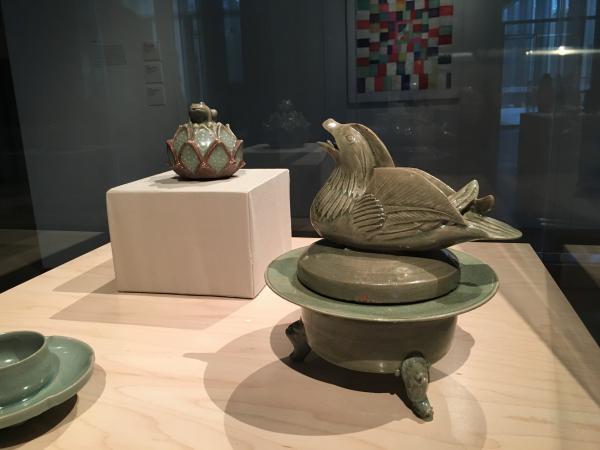The Korean galleries have some new occupants—but only for a short time. These temporary tenants are a duck-shaped incense burner and a water dropper in the shape of a frog sitting on a lotus bud, both from the Goryeo era, a period between 918 and 1392 renowned for its unique and beautiful ceramics.
Upon closer inspection I was struck by not only the skill with which the stylized animal forms had been rendered but also the sense of play that manifest in them. For example, the incense burner, which dates to the 12th century—traditionally, incense burners were used during Buddhist or ancestor-worship rituals as a means of purification. They operate by a simple yet elegant system tied to their physical form, that of a lidded bowl. The bowl’s body would have contained incense whose smoke, upon burning, would escape via a hole in the lid. It would have given the impression of smoke blowing out of the duck’s beak. Despite the solemnity implied by the incense burner’s function, the creativity of its design was integrated into its regular use.
The other loaned piece, a water dropper featuring a frog perched on a lotus bud, complements its neighbors with its impression of whimsy and decorative charm. It offsets the stateliness of the duck as well as the elegance and simplicity of the non-figurative ceramic objects also on display nearby. Water droppers such as the frog numbered among the essential implements used by scholars and artists. Water would be poured in discrete increments to mix with ground-up dry ink, creating the dark ink solution used for painting and calligraphy. Again, an item with a quotidian function nevertheless receives a skilled and thoughtful artistic treatment—the inclusion of the lotus flower derives from a pun on the Chinese words for “lotus root” and “to pass an exam,” leading to the popular superstition that lotus-shaped water droppers contributed to academic success.
The care with which even these objects were rendered and preserved led me to wonder about the life of these pieces, which survive from the 11th and 12th centuries. Who made them? Who were they for? Were they actually used, or just viewed for pleasure? This might call for another blog post.



